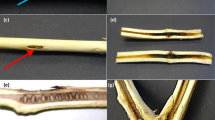Abstract
Bottom rot caused by Rhizoctonia solani is an increasing problem in field-grown lettuce in Germany. During the growing seasons of 1999 and 2000, 95 isolates of R. solani from lettuce plants with bottom rot symptoms were collected from eight locations. The isolates were characterised using hyphal anastomosis, pectic zymograms and morphological characteristics. Ninety-three isolates were identified as anastomosis group (AG) 1-IB, one as AG 1-IC and one as AG 2-1. Optimum hyphal growth was measured over a temperature range of 20–30 °C with an optimum at 25 °C. Aggressiveness of the AG 1-IB isolates varied from weak to strong when tested on detached lettuce leaves. The pathogenic potential of six AG 1-IB isolates was determined on 14 plant species in comparison with lettuce under conditions favourable for the fungus. Radish, broccoli, kohlrabi, spinach and millet seedlings were as severely infected as lettuce seedlings. The same isolates caused little symptoms on maize, tomato and onion. Knowledge about the host range of AGs of R. solani are important for planning an effective crop rotation as part of a control management system.
Similar content being viewed by others
References
Adams GC (1988) Thanatephorus cucumeris (Rhizoctonia solani), a species complex of wide host range. Advanced Plant Pathology 6: 535-552
Anderson NA (1982) The genetics and pathology of Rhizoctonia solani. Annual Review of Phytopathology 20: 329-374
Bandoni RJ (1979) Safranin O as rapid nuclear stain for fungi. Mycologia 71: 873-874 Carl ZeissVisionGmbH(1997) KS 400 Imaging System, Release 3.0, User's Guide Vol. 1.
Carling DE, Leiner RH and Kebler KM (1987) Characterization of a new anastomosis group (AG-9) of Rhizoctonia solani. Phytopathology 77: 1609-1612
Carling DE (1996) Grouping in Rhizoctonia solani by hyphal anastomosis reaction. In: Sneh B, Jabaji-Hare S, Neate SM and Dijst G (eds) Rhizoctonia species: Taxonomy, Molecular Biology, Ecology; Pathology and Disease Control (pp 37-43) Kluwer, Dordrecht
Carling DE, Pope EJ, Brainard KA and Carter DA (1999) Characterization of mycorrhizal isolates of Rhizoctonia solani from orchid, including AG-12, a new anastomosis group. Phytopathology 89: 942-946
Carling DE, Kuninaga S and Brainard KA (2002) Hyphal anastomosis reactions, rDNA-internal transcribed spacer sequences, and virulence levels among subsets of Rhizoctonia solani anastomosis group-2 (AG-2) and AG-BI. Phytopathology 92: 43-50
Cruickshank RH (1990) Pectic zymograms as criteria in taxonomy of Rhizoctonia. Mycological Research 94: 938-948
Davis RM, Subbarao KV, Raid RN and Kurtz EA (1997) Compendium of Lettuce Diseases (pp 15-16) APS Press
Kofoet A, Fricke A, Heine H, Hommes M, Richter E, Ulbrich A and Weier U (2001) Kopfsalatsorten und ihre Anfälligkeit gegenüber bodenbürtigen Pathogenen. Gemüse 37(10): 10-13
Kooistra T (1983) Rhizoctonia solani as a component in the bottom rot complex of glasshouse lettuce. Verslagen en Mededelingen No. 160, 444 pp. Plantenziektenkundige Dienst, Wageningen
Herr LJ (1992) Characteristics of Rhizoctonia isolates associated with bottom rot of lettuce in organic soils in Ohio. Phytopathology 82: 1046-1050
MacNish GC, Carling DE and Brainard KA (1993) Characterization of Rhizoctonia solani AG-8 from bare patches by pectic isozyme (zymogram) and anastomosis techniques. Phytopathology 83: 922-927
Ogoshi A (1972) Grouping of Rhizoctonia solani Kühn with hyphal anastomosis. Annals of Phytopathological Society of Japan 38: 117-122
Ogoshi A (1987) Ecology and pathogenicity of anastomosis and intraspecific groups of Rhizoctonia solani Kühn. Annual Review of Phytopathology 25: 125-143
Scheinpflug H and Heupel M (1998) Die Bedeutung der Taxonomie der Pilze für die Phytopathology. Zeitschrift für Pflanzenkrankheiten und Pflanzenschutz 105(3): 246-263
Schneider JHM, Schilder MT and Dijst G (1997) Characterization of Rhizoctonia solani AG-2 isolates causing bare patch in field-grown tulips in the Netherlands. European Journal of Plant Pathology 103: 265-279
Sherwood RT (1969) Morphology and physiology in four anastomosis groups of Thanatephorus cucumeris. Phytopathology 59: 1924-1929
Sneh B, Zeidan M, Ichielevich-Auster M, Barash I and Koltin Y (1986) Increased growth responses induced by nonpathogenic isolate of Rhizoctonia solani. Canadian Journal Botany 64: 2372-2378
Stone GE and Smith RE (1900) The rotting of greenhouse lettuce. Massachusetts Agricultural Experiment Station Bulletin 69
Thornton CR, O'Neill TM, Hilton G and Gilligan CA (1999) Detection and recovery of Rhizoctonia solani in naturally infested glasshouse soil using a combined baiting, double monoclonal antibody ELISA. Plant Pathology 48: 627-634
Tu CC, Roberts DA and Kimbrough JW (1969) Hyphal fusion, nuclear conditions and perfect stages of three species of Rhizoctonia. Mycologia 61: 775-783
Wareing PW, Zu-Nan Wang and Coley-Smith JR (1986) Fungal pathogens in rotted basal leaves of lettuce in Humberside and Lancashire with particular reference to Rhizoctonia solani. Plant Pathology 35: 390-395
Wolf PFJ and Verreet JA (1999) Untersuchungen zur Epidemiologie und Schadrelevanz der Rhizoctonia-Rübenfäule (Rhizoctonia solani Kühn). Gesunde Pflanzen 51(5): 133-140
Yang XB, Snow JP and Berggren GT (1989) Morphogenesis of microsclerotia and sasakii-type sclerotia in Rhizoctonia solani, anastomosis group 1, intraspecific groups IA and IB. Mycological Research 93: 429-434
Yang XB, Snow JP and Berggren GT Jr (1988) Survey of reproductive forms of Rhizoctonia solani on soybean in Louisiana. Plant Disease 72: 644
Zens I and Dehne H-W (1997) Rhizoctonia solani-Die späte Rübenfäule und Differenzierung des Pathogens. Mitteillungen der Deutschen Phytomedizinischen Gesellschaft 27: 32
Author information
Authors and Affiliations
Rights and permissions
About this article
Cite this article
Grosch, R., Schneider, J. & Kofoet, A. Characterisation of Rhizoctonia solani Anastomosis Groups Causing Bottom Rot in Field-Grown Lettuce in Germany. European Journal of Plant Pathology 110, 53–62 (2004). https://doi.org/10.1023/B:EJPP.0000010137.69498.10
Issue Date:
DOI: https://doi.org/10.1023/B:EJPP.0000010137.69498.10




